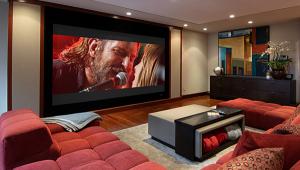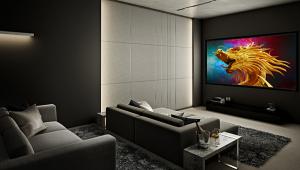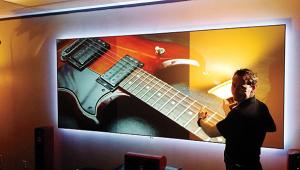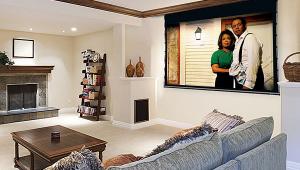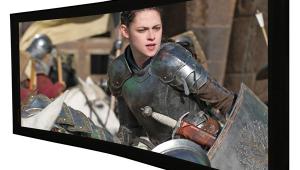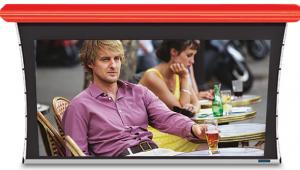Bought one of these a few years ago. They would fail after about six months. Use was maybe once a week. Elite warrantied the first couple, but then simply refused. Sent me a manual screen and considered it case closed. Avoid.
Elite Screens Kestrel Tab-Tension 2 CLR 3 Series Screen Review

AT A GLANCE
Plus
Screen fully retracts when not in use
IR and RF remote controls
Very good value
Minus
Slight slackness at screen’s bottom edges when extended
THE VERDICT
The Elite Screens Kestrel is a well-made, reasonably-priced, and easy-to-set-up option for those who want their projection screen to disappear when it’s not in use.
Plenty of custom solutions have been developed to house ultra-short throw (UST) projectors, a category designed to beam bright, living-room friendly images from a position just a few inches away from the bottom edge of the projection screen. The main ones are furniture-grade cabinets with an interior compartment for stowing away the projector so it remains out of sight both in use and when powered off. Screens designed for UST projectors, on the other hand, are for the most part fixed-frame designs that occupy a large amount of wall area, especially the 120-inch diagonal format commonly used for UST setups. Given that such screens typically have a dark gray surface, anyone using them needs to contend with having the equivalent of a big black hole (okay, a dark gray rectangle) on their wall when the projector is turned off.
The Kestrel Tab-Tension 2 CLR 3 ($2,320-$2,905) is Elite Screens' answer to the UST black hole dilemma. A tab-tensioned rollable material housed in a motorized case, the Kestrel rises from the floor at the flick of a switch to full height for movie or TV viewing, and then retracts back into place when you're done. It's a simple, elegant solution for UST projector owners seeking a screen that disappears when it's not in use—and one that doesn't require any installation prowess beyond positioning the case on the floor and plugging it in.
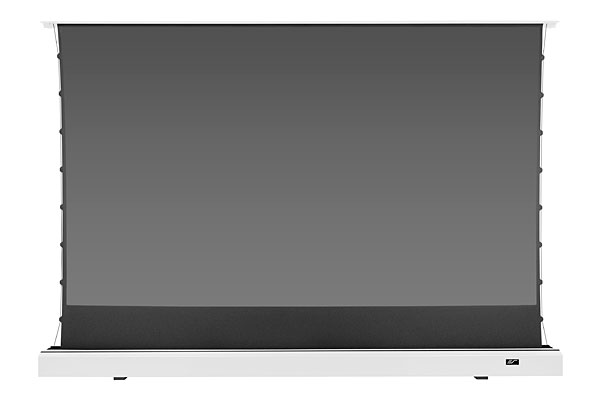
Elite Screens shipped me a 101-inch version of the Kestrel in a white housing (there's also a 121-inch screen size and a black case option). Both sizes are only available in a 16:9 aspect ratio. A cardboard shipping container that arrived at my doorstep containing the Kestrel was a bit over 9-feet wide, making getting it into the house a two-person job, but once inside, I was able to unbox and position the screen's 97 x 4.5 x 6-inch case on my own. The case is constructed from sturdy aluminum and features rubber feet for installation on a wood floor. In operation, an equally sturdy cross-rising spring scissor mechanism emerges from within to raise the screen up to the desired height, and then folds back on itself when retracting. An aluminum panel sits on top of the mechanism and serves as a "lid" when the case is fully closed up.
There are multiple ways to operate the Kestrel once it's plugged into a power outlet. The most basic is a switch located on the left side of the case that lets you manually raise, lower, and stop the screen. Two remote handsets with similar functions provide RF (radio frequency) and IR (infrared) wireless control, respectively. Another option is a wireless RF trigger dongle that plugs into your projector's USB port and sends out commands to raise and lower the Kestrel synched with your projector's power on/off cycle, though I was unable to get this to work with the Epson LS-500 model I used for my evaluation.
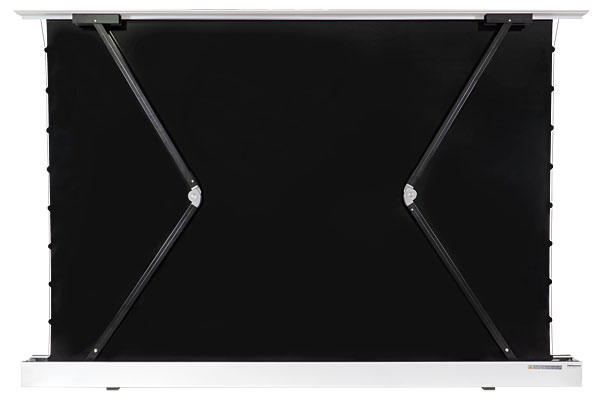
The CLR 3 (ceiling light-rejecting) screen material used by the Kestrel has a gain of 0.8 and is spec'd for a 170-degree viewing angle. Like other materials designed specifically for use with UST models, it features an optical coating that is aligned to filter out light coming from above the screen while reflecting light coming from a projector positioned below (this accounts for the screen's dark gray appearance as noted above). Black backing on the back surface, meanwhile, blocks out any light coming from behind the screen when it's extended. While the CLR 3 does an impressive job of filtering out overhead light, it doesn't have the same effect on light hitting the screen from the left and right sides—something that regular ambient light-rejecting (ALR) screens are designed to do. For this reason, to get best performance out of your setup, you'll need to make sure windows in your viewing room can be adequately blacked out, and that any room lamps to the sides of the screen are switched off or dimmed.
Note: The Where to Buy link below is an affiliate link. If you purchase through the link, we may earn a small commission at no extra cost to you. Thank you for your support!
- Log in or register to post comments

This is a practical and well-designed solution for those with ultra-short throw projectors. | local handyman

Beauty is more than skin deep; it's about embracing your unique essence and radiating confidence. With Nikol Beauty, every product is a testament to celebrating your individuality and enhancing your natural allure.

The Elite Screens Kestrel Tab-Tension 2 CLR 3 Series Screen is a high-quality projector screen designed for both residential and professional use. With its tab-tension system, the screen ensures a smooth, wrinkle-free surface, providing optimal image clarity. The CLR (Ceiling Light Rejecting) technology enhances the viewing experience by blocking ambient light, making it perfect for bright rooms. The 3 Series also boasts a sleek, modern design that complements any space, making it a top choice for those looking for a premium viewing experience. For further insights on various tech products, you can check out this https://writeverge.com/

The Elite Screens Kestrel Tab-Tension 2 CLR 3 Series is a well-designed, retractable projection screen ideal for ultra-short throw (UST) projectors. It combines convenience, value, and functionality, making it a great choice for modern home theaters. However, slight slackness at the edges when extended is a minor drawback.
For the Tech trends 2025 and insights into home entertainment innovations, visit our website.

The Elite Screens Kestrel Tab-Tension 2 CLR 3 Series is a high-quality, reasonably-priced projection screen designed to disappear when not in use, making it ideal for those seeking a clean look in their living spaces. While it provides a smooth and tensioned surface, a slight slackness at the bottom edges can be noticed when fully extended. For seamless integration with ultra-short throw projectors, this screen is an excellent choice. Interested in other entertainment options? Check out Manok Na Pula APK for additional fun.

Кўпчилик Sun of Egypt 2’ни куннинг қайси вақтида ўйнаш яхшироқ эканлиги ҳақида қизиқади. Мен шахсан эрталабки соатларда ва кечқурун яхши натижалар олганман. https://sun-of-egypt-2.com/ сайтида ўйнаб, статистикани кузатиб, қайси вақтда бонуслар кўпроқ чиқишини билиб олдим. Лекин асосийси – сабрли бўлиш ва муваффақиятли стратегияни танлаш. Энг яхши тактика – секин-аста ставка ошириш ва эмоцияларга берилмаслик.

The Emirates ID card photo should be high quality, coloured and not older than six months. The Emirates ID photo background colour must be white

